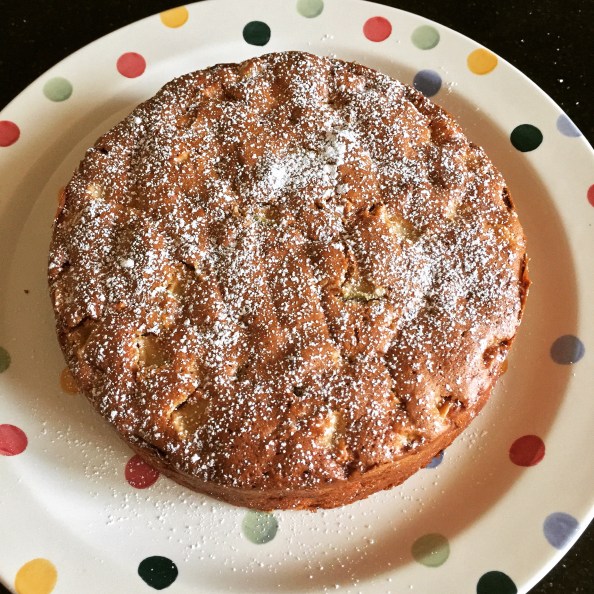When we had our Aga installed in our new kitchen twelve years ago, we considered making space for a conventional hob and oven so that we could turn the Aga off during the summer months as many Aga owners do. We decided against it though, partly because the kitchen lay-out didn’t really allow for it and partly because I felt that if I was going to be an Aga cook it should be the whole year round. I have not regretted this decision. Until this summer that is. I have found myself occasionally cursing the Aga while melting into a puddle on the kitchen floor. It has just been so hot that the last thing I want to do is stand near the Aga, let alone open its doors and place things in it! If it weren’t for the ability to open wide the large sash windows of our Victorian house, I might have left home by now!
That was a rather long-winded way of explaining that the reason I haven’t posted any Aga recipes lately is because I haven’t been cooking many. Mind you, I don’t think it’s only Aga owners like me who’ve not felt much like cooking during this heatwave. I get the impression we’ve all been making salads and barbecuing. But at some point last week it cooled down a little and even rained. Last Sunday dawned wet and windy: normal summer had returned and I was perfectly happy pottering about in the kitchen “around the Aga” making lunch. I opted to make an old favourite from Delia Smith’s Summer Collection book  which was hugely popular when it came out in 1993. All my friends seemed to be cooking from it, whether it was Piedmont Roasted Peppers, Thai Salmon Filo Parcels or Pesto Rice Salad. Some of the ingredients in the recipes (fresh coriander, lemongrass, pesto, chillies, couscous) were new to us or at least not part of our daily repertoire and not always easy to get hold of. The Chicken with Sherry Vinegar and Tarragon recipe is Delia’s Spanish take on the classic French Poulet au Vinaigre, and I’ve adapted it slightly for the Aga.
which was hugely popular when it came out in 1993. All my friends seemed to be cooking from it, whether it was Piedmont Roasted Peppers, Thai Salmon Filo Parcels or Pesto Rice Salad. Some of the ingredients in the recipes (fresh coriander, lemongrass, pesto, chillies, couscous) were new to us or at least not part of our daily repertoire and not always easy to get hold of. The Chicken with Sherry Vinegar and Tarragon recipe is Delia’s Spanish take on the classic French Poulet au Vinaigre, and I’ve adapted it slightly for the Aga.
Chicken with Sherry Vinegar and Tarragon
(Serves 4)
Ingredients
- 8 chicken thighs or a whole chicken jointed into 8 pieces
- 150ml sherry vinegar
- 425ml medium-dry Amontillado sherry*
- 12 shallots, peeled and left whole
- 4 cloves garlic, peeled and left whole
- 2 tbsps olive oil
- 2 tbsp fresh tarragon leaves
- 1 heaped tbsp crème fraîche
- Salt and freshly ground black pepper
- A few more sprigs of tarragon to garnish
Method
- Season the chicken pieces and brush with a little of the oil
- Heat a large frying pan or sauté pan on the simmering plate and add the chicken, skin side down, to brown it. You can do this by leaving the pan on the simmering plate, but to stop your Aga losing heat (remember the 80/20 rule which says you should do 80% of your cooking in the ovens and no more than 20% on the hot plates), you can place the pan on the floor of the roasting oven to do this. Once golden brown, turn the chicken pieces over to do the same on the other side
- Remove the chicken to a plate, return the pan to the simmering plate and add the remaining oil followed by the shallots to brown them a little
- Add the garlic cloves to colour them slightly
- Return the chicken pieces to the pan, scatter the tarragon leaves over, then pour in the vinegar and sherry
- Bring it up to simmering point and transfer it to the simmering oven to braise slowly. You know the drill: it will not come to any harm in there. Probably needs about an hour so here so if you want it to cook more quickly I suggest you put it in a hotter oven (baking oven if you have one) for 30 minutes or so. Halfway through the cooking time turn the chicken pieces over
- When you’re nearly ready to eat remove the chicken pieces, shallots and garlic from the pan while you whisk in the crème fraîche. The sauce should be thick by now but you might want to bring it to the boil on the simmering plate to reduce it a little further
- Check the seasoning and then either return the chicken and shallots to the pan (if it’s nice enough to serve it in) or pour the sauce over the chicken in a suitable serving dish
- Garnish with the tarragon sprigs
* As you know, with Aga cooking there is less evaporation meaning that less liquid is required. I have given Delia’s quantities here but in all honestly there was a lot of sauce and I think I could have used about 100ml less sherry.









































